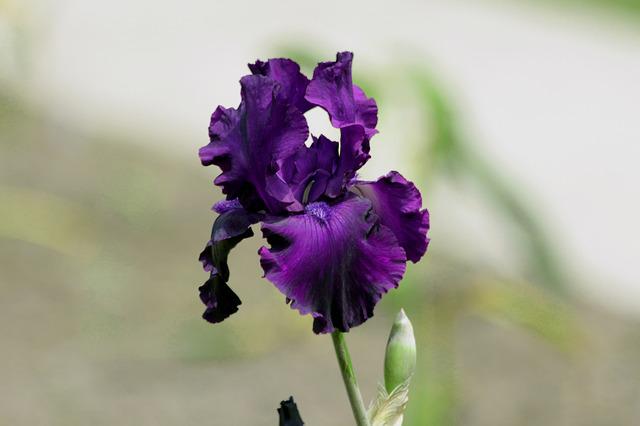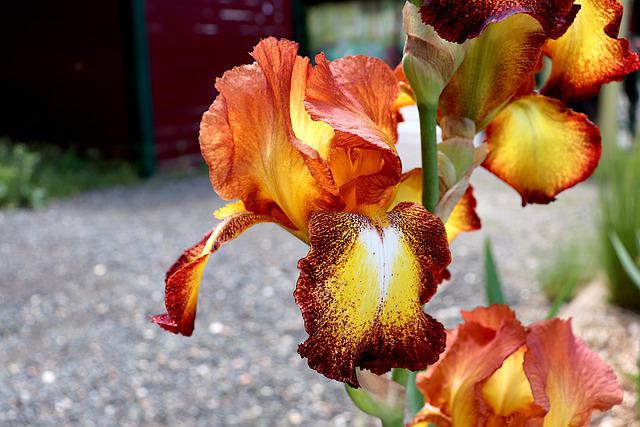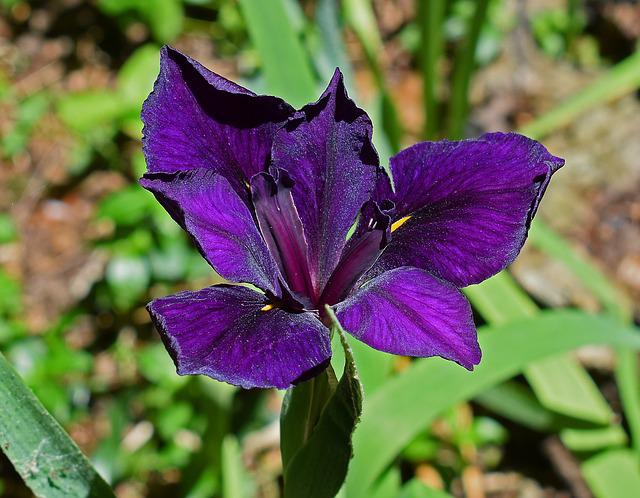Can Irises Grow In Water?

There are a few types of irises called hydrophilic, like water. These water garden irises are good at preventing soil from being washed away by natural ponds and streams because they have a lot of long roots. This isn’t the only good thing about them. They can also get rid of toxins from water.
Table of Contents
Types of Water-Loving Irises
True Water Irises
They grow best when they have water on their crown all year. They are plants that live in the water but aren’t completely submerged. They grow all over the place in the water. Most will also grow in wet soil near a pond or stream, or even in a wet spot in the garden. False water irises are not true water irises at all. They are not Iris laevigata, which is the true water iris. They are Iris fulva, which is the Copper Iris. They are also Iris pseudacorus, which is the Yellow Flag (Dixie Iris).
Bog Irises
During some parts of the growing season, they prefer wet soil, but they can grow in dry soils for the rest of the year. They can grow in shallow water, but they won’t be able to stay in the pond all year long. They would then have to be moved out of the pond and to a dry place in the winter. Iris setosa is a type of bog iris. Iris ensata is a type of Japanese Iris. Iris sibirica is a type of Siberian Iris. Iris missouriensis is a Rocky Mountain Iris ( Wild Flag Iris).
Water-Loving Irises
True Water Irises Live in Water all Year Long
Louisiana Iris
Iris ‘Black Gamecock’
This plant has flowers that grow up to 6 inches wide and open flat to show off their velvety deep purple flowers with the tiniest gold signal on each petals each year. The bloom time varies depending on where you live, but it usually starts in late spring and lasts through the middle of summer. This is, without a doubt, one of the most beautiful native plants.
Copper Iris
Iris fulva
In the United States, Iris fulva is called “copper iris” because its flowers are a unique copper color. It is a Louisiana Iris that doesn’t have a beard or crest. It is found in swamps and wetlands. Bald cypress swamps, sloughs and lakes are where it is most common in Missouri. It is also found in swampy woodland areas. It is often found growing and blooming in areas that have been flooded in the spring. As the summer goes on, these areas usually dry up.

Dixie Iris
Iris hexagona
There are very few plants in the Iridaceae family called “dixie iris.” They can be found in a wide area from South Carolina to Louisiana. When it grows outside, it likes wet and sunny areas, like marshes, ditches, swamps, and the banks of streams or rivers in areas close to the coast.
This herbaceous perennial grows to 3-4 feet tall and spreads 1-1.5 feet. The leaves die back after the flowers bloom in early spring, but they come back in the fall for the next year’s growth. It prefers full sun, but it can grow in some shade and wet or acidic soil. A thick layer of wet mulch can help some dry soils. This will keep the soil cool and keep water from evaporating.
Water Iris
Iris laevigata
Rabbit-Ear Iris is a low-maintenance perennial that comes from the Far East. It’s great for a spot in the yard that gets a lot of water. Native to its home country, this plant likes to grow in shallow water and prefers ponds that are wet and dry. It can also be grown in wet soil if the conditions are right, but only if they are. This plant is different from other irises in that it needs a lot of water. As long as the seeds germinate, it’s a simple plant to grow and can bloom from late spring through early summer and occasionally into the fall.
Flowers are usually blue, purple, or violet, but they come in a wide range of colors. Some types have mostly white flowers with blue spots and dark purples with white borders. With full sun, it needs acidic or rich soils and at least 2″ to 8″ of standing water. Part of the time, it can live in the shade, and the soil is alkaline. Putting a lot of them together near ponds or streams makes them look great. They also look good in a border or cottage garden that isn’t dry.
Variegated Water Iris
Iris laevigata ‘Variegata’
Perfect for water that is still. It looks great with its display of 4 in. (10 cm) wide, rich blue-purple flowers, with broad pendant falls showing a white central ridge and slightly narrower, upright standards that aren’t as wide. This Iris may bloom again in the fall. It will be on show from late spring to early summer. There are clumps of upright, narrow, blade-shaped leaves heavily striped with creamy-white. The flowers are as beautiful as the foliage. One of the best things about this Iris is that it doesn’t fade in the garden.
Yellow Iris
Iris pseudacorus
Yellow flag iris, or “flag,” grows wild throughout North America’s wetland areas, except in the Rocky Mountain states. Although it is not indigenous, it readily naturalizes.
Not only does it have lovely flowers, but it also has striking sword-shaped leaves (1 1/8 inches wide) in a lovely greenish-gray color. The large seed pods that follow the blossoms are ideal for dry flower arrangements.
Its advantages extend beyond the fact that it brightens up the yard. Additionally, it is a low-maintenance plant useful as an ornamental pond plant. It is prized for its ability to thrive in moist areas of the landscape where many other plants would struggle and its deer resistance.

Blue Flag
Iris versicolor ‘Kermesina’
There are lance-shaped grey-green leaves on “Kermesina.” It grows to about 80cm tall and lasts for a long time. Five reddish-purple flowers with yellow and white veins can be found on each branch. Flowers bloom from early in the summer to the middle of the summer. This cultivar is great for planting near ponds in sunny and wet areas. Plant in deep, moist to wet, acidic soil. Will not stand for dying out.
Southern Blue Flag
Iris virginica
This delicate iris can be found in the eastern United States and Canada as far west as Texas. It can grow to two to two and a half feet, and its naked stems bear light blue to violet flowers in the late spring. The falls are white-lined and can have a yellow frill atop them. They are not as upright as the strap-like leaves and have a pronounced midrib in the center.
Ideally, it should be grown in a wet, humusy to sandy soil with full sun exposure in a bog or acidic area. It’s normal in wild areas with standing water and shouldn’t be allowed to dry out during the growing season. Use these iris in pond borders up to 6 inches deep and leave them in the water all winter. It can tolerate some light shade in the warmer parts of its range. Flag of the South When clumps form, the rhizomes of iris can be divided for further propagation.
Blue Flag ‘Gerald Darby’
Iris x robusta ‘Gerald Darby’
The water is a beautiful hybrid of the two. Iris, the American Blue Flag, hails from North America. It puts on a spectacular show for many months of the year.
Flowers appear at the ends of nearly black flower stems as the season progresses from spring to summer, transforming the foliage from deep purple to green at the tips. This water Iris thrives when planted in boggy or shallow areas, but it can also thrive in a garden bed or large pot if it receives adequate watering throughout the growing season.
Bog Irises Thrive in Wet Soils for Part of the Growing Season

Zigzag Iris
Iris brevicaulis
It’s a low Iris that’s normally found in moist areas such as swamps and mesic woods, but it does well in regular garden soil. Because the flowering stems are short and only reach a height of 5 inches above the foliage, the plant got its common name. It’s common for the “zig-zags” to be in 45-degree angles to the flowers. During the month of June, the deep bluish-purple flowers with yellow and white-crested falls appear (the petals that hang downward). Short-lived flower Ideal for edging streams and ponds and other waterways. Spring and autumn bring beautiful displays of foliage (dormant in summer).
Rocky Mountain Iris
Iris missouriensis
It has slender stems and grows to a height of one to two feet. There are one to four flowers on each stem. These lilac-purple blooms can range in color from light to dark, and they have a yellow base color. There are a lot of grayish-green leaves on this plant. It is the tallest, leafless (or with a single shortleaf) stalk of sword-shaped, flexible, tough and pale blue or blue-violet flowers that bear the delicate, purple-veined flowers. Large clumps of this species can be found in low areas of pastures where cattle avoid the tough leaves.
Slender Blue Iris
Iris prismatica
This plant is indigenous to the Atlantic coast from Georgia to Maine, where it can be found in salt, brackish, and freshwater marshes, fields, and along shorelines. Shores of rivers or lakes, tidal marshes, meadows and fields, and salt or fresh tidal marshes and flats.
Bristle-Pointed Iris
Iris setosa
Iris setosa resembles a miniature Japanese iris, or a dwarf version of Iris sibirica, but it has a shorter life span than the larger Iris sibirica. Large clumps of shallowly rooted, branching rhizomes grew over time. Its rhizomes are thick, grey-brown, and covered in old, fibrous leaf remains (which are maroon-brown in color) (of last seasons leaves).
Japanese Iris
Iris ensata
It comes in a variety of shades of purple, blue, and white, with attractive medium-green foliage, making it a versatile perennial choice. Taking care of a Japanese iris is not difficult if the plant is placed in the proper location. The timing of the planting of Japanese irises is also critical to their success.
Siberian Iris
Iris sibirica
An easy-to-grow perennial from Central and Eastern Europe, the Siberian Iris grows to a medium height and is low maintenance thanks to its clumping nature. If you are looking for a specimen plant, look no further than this plant. Most cultivars of Siberian Iris bloom in shades of blue-purple, but white, pink, orange, red, and yellow have been introduced. When it comes to Greek mythology, iris means “goddess” or “rainbow.” In the past, its blooms have served as a symbol of monarchs and the royal family. For the French word ‘fleur-de-lis,’ the shape of the flower is what inspired the design. Siberian Iris typically grows to a height of 2 feet, but some cultivars can reach even higher heights than that. Clumps can produce 12 to 20 flowers when they flower profusely.
